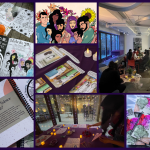November 22, 2006, when I posted my first post to this blog, seems like a lifetime ago (not in a bad way). And I know now that anyone who says that a job is just a job has never worked at The Women’s Foundation.
For when I was handed the reigns of this blog, and given the responsibility of managing The Women’s Foundation’s communications and marketing, I had no idea that what I was truly being handed was a genuine community–a community committed to changing our region by investing in women and girls.
I know, I know–it sounds like a marketing pitch. A line. A brand. A lot of nonprofit mission mumbo jumbo.
But I guarantee you, I’m not a good enough salesperson to be able to sell something I don’t believe in. Just ask my mother.
Have you seen my gameface? No.
Because I don’t have one.
But in this position, I’ll admit, I did get a marketing platform, a brand, to draw upon. And it made my life easier–not because it was a brand, but because it was true.
So, on my last day as The Women’s Foundation’s Director of Communications, I thought I’d unveil a bit about the brilliant tool that Susan Hasten and her colleagues at AXIS Communications put into my hands a few months after I came on board, and prove to you that it is, in fact, who we are here at The Women’s Foundation.
At least from my perspective.
For more than two years, the post-in note on my computer has had four words that have defined not only my work, but The Women’s Foundation. Writing and speaking and thinking to and from them has not been a challenge. For they speak for and to who we are.
Here’s how:
Community
The Women’s Foundation is, indeed, a community. I have been honored to get to see it work from a number of perspectives. And so have you.
Our donors give not only from their bank accounts, but of their time and talent to change our community. From Rainmakers to members of the African American Women’s Giving Circle to 1K Club members to Washington 100 members to the folks at Hobo International who donate the handbag centerpieces at our annual luncheon, our donors are thoughtful, smart, savvy, and commited to social change.
They want to roll up their sleeves and get involved and they do.
Michael Colella has been taking the pictures that have enabled us to demonstrate the power of our work for years, as a volunteer, 100 percent of the time. His commitment to our work and our mission extend beyond what I can convey here. They say a picture is worth a thousand words, but I’m not sure even that would do it. And in the meantime, he’s kept me laughing even when we were working way after hours and ready to throw up our hands the night before the luncheon.
The Bivings Group, which developed and helps manage TheWomensFoundation.org (pro bono mind you), helped me figure out how to blog effectively, grow this site, and made our online votes and tons of other online initiatives possible. Their knowledge, patience with me ("I can’t get the photo to upload!") and dedication to our work has astounded me every step of the way.
Jennifer Cortner (a board member and chair of our communications committee) and her colleagues at EFX Media have worked tirelessly to bring our work to life on video, while Jennifer has served as a mentor, teacher and friend to me as I made my way through video posting, luncheon production, and print layout (Wayne, Jessica, and Roberto, thanks for not killing me over those Community Update layouts).
And now we have RP3, which has stepped in to support our print publications, luncheon theming and countless other aspects of our work (again, pro bono). They are creative, committed and their understanding of and ability to reflect our mission and work back to us with their beautiful layouts, design and concept ideas has done nothing but floored me since I first met Beth and Kristi.
And, of course, there is The Hatcher Group, which supports our media outreach. From Angie–who has taught me more about media, writing op-eds, press releases and just generally getting the word out, while also being a tremendous mentor and friend, to Josh–who came in and showed me everything I ever needed to know about social media in two hours or less, their impact on our work cannot be overstated. They are constantly thinking about how they can help us promote our work and the interests of women and girls thorughout our community and it has been a true pleasure to work with them.
And in addition, a few years ago, they said, "We’d like to work with your Grantee Partners (at no extra charge), to help them with their media capacity." Ever since, we’ve picked a few partners each year to work one-on-one with them, resulting in stories like this one on The Art League and one on Fair Fund in the Washington Post–among many other positive outcomes that emerged from their work.
Then there is the staff of The Women’s Foundation: my colleagues and, now, good friends. My colleagues are smart, hard working, mission-oriented people for whom I have the greatest respect. They are also kind, funny and good-hearted. Some of them microwave Tootsie Rolls, but hey, we all have our issues.
In any case, it has been a pleasure to work with them, and to coax them into the crazy online world that is the blogosphere, Twitter and Facebook. They have been patient with my antics, and eventually downright supportive. Some, we could say, took that ball and ran with it (Gwen) in ways that even I hadn’t fathomed, and have made significant contributions to the thinking and dialogue around issues impacting women and girls in our community. (Even if it was "age-inappropriate.")
A few samples of their posts can be found here, here, here, here, and, here, and pretty much all over the place. Their writing, thinking and work daily makes me proud to have worked alongside them.
It has been a priviledge to know and work with these committed women and men and to see this side of my community.
Many, many times I have been asked how The Women’s Foundation has managed to have such superb media coverage, outreach and publications, and my answer is always that it’s because we have an extensive network of true partners standing behind us, committed to our work, our message and our mission.
It is these people, and those I am sure I am forgetting to name, who, very honestly, have given The Women’s Foundation its voice in our region.
Connect
Broadly, this refers to The Women’s Foundation’s ability to connect Grantee Partners with resources, women to other women to make their community activism and giving more effective, and to make connections between the women and girls who need support and those who can help provide it.
In my work though, it has meant building connections through the online, offline and various worlds of communications. And it’s been great, great fun.
Starting when Donna Callejon, our former board member and social media guru and mentor to me, said, "You have to go on Facebook."
"Ugh, really?"
And so we did. 425 Cause members later, I’d say we’re pretty connected. (Not to mention that I’ve reconnected with almost my entire high school debate team, but that’s another story.)
Then it was Twitter.
"Seriously?"
But 605+ Followers later, she may have been onto something.
Then she said, "Can we please take ourselves less seriously sometimes? I know our work is serious, but do we always have to be?"
We listened, and tried out this and this.
Then she said, "And can the blogs please be shorter?"
Mostly, we ignored her on this point. #verbose
Inspire
And here is where I get to talk about our Grantee Partners and the women and girls whose lives they transform each and every day. Lives like Linda Butler and Christine Walker and the women and girls served by Polaris Project and other local organizations fighting human trafficking.
Their stories are endless, and so is their impact. It will go on for generations, ebbing through individual lives, families and communities.
In my work, I have had the privledge of learning about and telling their stories, over and over.
It has been an honor to do this, and inspiring beyond words (Yes, even for me).
In telling the stories of how our Grantee Partners are changing lives through jobs in construction, rehabilitation after prison, and helping prevent and help women and girls gain freedom after being trafficked, among countless others, I knew that I was only doing half of my job.
That as part of The Women’s Foundation’s mission to raise the voices of women and girls, that we had to also raise theirs.
I was inspired to start office hours around communications and marketing, to learn about their needs and stories and challenges and to try to help ways to foster awareness of their work despite small budgets, lean staffs and workloads that were spiralling further and further out of control as the recession deepened.
And from that, I was astounded to see that despite these challenges, their voices rose.
They started blogs, like this one, this one and this one. They started Facebook pages and then began to Tweet, here, here and here.
Just to name a few.
Transform
And in that process, I was truly and genuinely changed.
I went from being content writing and talking about this work to wanting to do it.
I was inspired by more of our Grantee Partners than you can name, and not a small group of donors and members of the larger community around The Women’s Foundation, but it was the day that I wrote this that I knew that the next step for me would be to go into direct service.
So I applied to graduate school and will begin a full-time Master’s program in social work this fall.
And thus, 829 posts later, I find myself saying a very bittersweet farewell, to a community that has connected me to the leaders and visionaries and philanthropists that have inspired me to make a change.
Personally and professionally.
So as you can see, it is much more than a branding platform.
It is who we are. It is truly, and genuinely, what we do.
As of close of business today, Lisa Kays is no longer the Director of Communications at The Women’s Foundation, but is honored to have been for the past (nearly) three years. She is currently a full-time student pursuing a Master’s degree in social work.



